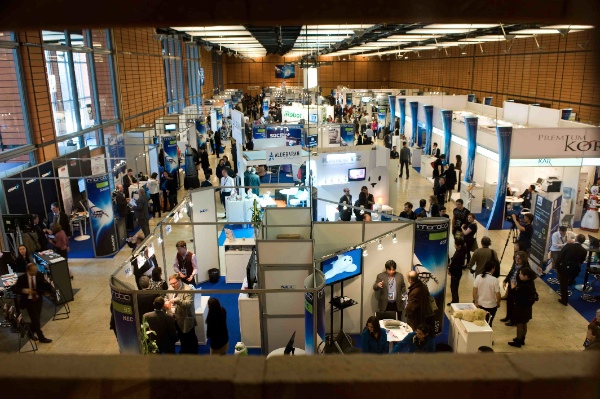Humans and Robots Converge at Innorobo 2013
From March 19th to the 21st, record crowds came into Cite Internationale in Lyon, France, with over 15,000 entries for Innorobo 2013, an annual conference centered around the demonstration of today's service robots. Featuring everything from commercially available products to cutting-edge robot concepts, the event is a playground for tech toys of tomorrow.
 Catherine Simon, president of Innoecho and organizer of the event believes that the Innorobo's 25 percent growth over last year reflects much more than the success of this event alone.
Catherine Simon, president of Innoecho and organizer of the event believes that the Innorobo's 25 percent growth over last year reflects much more than the success of this event alone.
“This important increase, despite the economical crisis situation, shows the awareness of the potential of service robotics, not only from public institutions, but also from many other sectors of activity such as transportation, household appliances manufacturers, or yet again from digital & telecommunication companies, as well as the opportunity of growth by the innovation. This year at Innorobo, people were coming to do business, the professional curiosity phase is behind.”
Innorobo is unique in its focus on live demonstrations, designed to bring attention to the latest technologies that are ready for implementation. It is the only event in its kind, with the next closest events happening in Asia and the U.S.
The event was held concurrently with the European Robotics Forum, which hosts over 300 of the top robotics experts from the European Commission each year. So after attending workshops and conferences at the ERS about industry innovations, they could simply walk downstairs to see the service robots they were talking about in action. Simon was especially pleased by the extra dimension this interplay added to each event.
On the outside, service robots sound a lot like their industrial counterparts: they perform semi- or fully-automated tasks to help lighten the load for human beings, although this definition usually excludes manufacturing applications. However, Simon was quick to comment that as robotics become increasingly sophisticated, this distinction is quickly losing its significance.
Simon noted two exciting trends that were evident at this year's conference that denote the potential for major progress in robotics technologies. The first is the convergence and growing interdependence between robots and the Internet. To the human user this adds a physical dimension to a virtual experience, allowing them to remotely and physically act in the real world.
Simon's second trend was increased collaboration between robots and workers in the workplace, especially with regard to industrial robotics and manufacturing applications.
Specific projects that garnered much attention all revolved around a shrinking gap between robotic technology and their human operators, with potential applications ranging from VoIP to the study of human paralysis.
 Arguably the most popular among these was Salamandra Robotica II, a robot from the Biorobotics Laboratory at the École Polytechnique Fédérale de Lausanne that can transition from swimming to crawling. One aspect of the model that's particularly promising is the salamander's digital neural network, which controls the machine's movements in the same way a spinal cord would.
Arguably the most popular among these was Salamandra Robotica II, a robot from the Biorobotics Laboratory at the École Polytechnique Fédérale de Lausanne that can transition from swimming to crawling. One aspect of the model that's particularly promising is the salamander's digital neural network, which controls the machine's movements in the same way a spinal cord would.
“The robot is not a goal in itself,” explained researcher Kostas Krakasiliotis. “It is about trying to reproduce the neural system to help understand our own neural networks.”
To help accomplish such an understanding, roboticists teamed up with neurobiologists, who have helped to create a machine that is not deterred by either land or water.
Taking advantage of the Internet was PhD research student Kohei Ogawa's robot, Telenoid. Not only does this design offer its users the ability to physically interact with a remote environment, its goal is to eventually transport them there. Ogawa's goal is to reimagine the status quo of telecommunications, or “use a robot to achieve tele-existence, where you transfer human presence to another place.”
Ogawa has built a telenoid robot that looks somewhat human externally while harboring its own version of Skype internally. This means that not only can your new VoIP talk, it can also move its head and arms to offer 'virtual hugs' by registering your gestures via motion sensors.
For the time being, however, the project lives at the Intelligent Robotics Laboratory at Osaka University in Japan. The same lab is headed by Professor Hiroshi Ishiguro, who was made famous by his robot doppelganger, Geminoid.
Robots weren't the only newsworthy additions to this year's conference, however. French ministor Arnaud Montebourg announced his national robotics plan, “France Robot Initiative,” which will donate €100 million to help SMEs gain the robotic equipment they need to stay competitive.
In light of this announcement, Simon is hopeful for the future, but admits that the trajectory of robotics can be hard to forecast because its growth as a market is driven by innovation rather than demand.
However, she noted three exceptions where robots have stepped in to fill a vital role and are likely there to stay: helping the handicapped, improving quality of life and ensuring sustainable development.
While tools to help the handicapped are fairly self-explanatory, these last two examples can sound a bit nebulous. But robots designed with quality of life and mind are already household items for many Americans. Take for example the autonomous vacuum cleaner called the Roomba, which is only one of many robots that could soon take tedious domestic tasks such as floor or window washing off your hands.
As far as sustainability is concerned, robots have already proven useful from our farms to our streetlamps. Because robots can bring precision that humans cannot, they can detect exactly where herbicides should be deposited, or the precise moment when a light should be turned on, reducing waste and curbing pollution.










